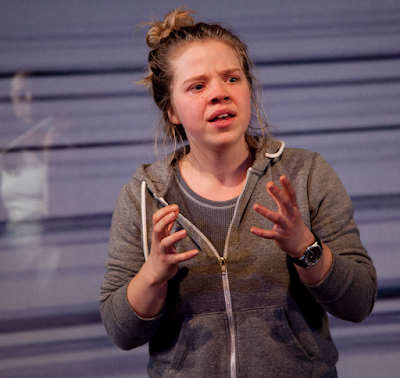Over the course of the play
Andrea plays a suite of solo violin pieces, written by composer Njo Kong Kie,
on her 1689 Baumgartner Stradivari (on loan by the Musical Instrument Bank of
the Canada Council for the Arts). I sat
down with Andréa last week and spoke to her about her process of working with
Kong Kie, her relationship to the music of the play, and her experience as a
performer in live theatre.
Andréa,
you’ve been working very closely with Kong Kie on the interpretation of the
music he has written for Infinity. How
has your approach to playing Kong Kie’s music differed from how you would
approach the work of another composer?
Andréa: It’s really amazing to work with a composer in person. One of the best things about playing
contemporary music is that you have that chance and you can ask the composer
questions. But also just by getting to
know them you can already sense or know what their their values are, what’s
really important to them.
And also, you can see that what’s written
on the page may not necessarily be what the composer means – through no fault of
their own – but we’re just really restricted on the page.
There was a lot that Kong Kie could tell me
when we were rehearsing. There was a certain aspect of rhythmical precision and
dynamic precision and tempo, which is really interesting because tempo is very
closely related to time. And Kong Kie’s very specific about tempo and how it
feels. So I think he was very well
chosen for this.
Kong Kie also worked really closely with
Ross so that the tempo really felt right. You know: how to take one scene and
send it into the next one.
It was fun getting to know Kong Kie better
because I met him in 2010 in Banff. And we were just friends and I played a few
pieces of his back then. I had no idea
that I’d see him again or that I’d work with him. It was a nice surprise when I began Infinity: that I already knew him and
that we could take it from where we left off.
Kong Kie & Andréa during Infinity's reading at The Koffler Centre
From
knowing Kong Kie’s work from Banff, does the music that he wrote for Infinity feel familiar to you in some
way? Or do you feel there is something different at work in this suite?
Andréa: I think he writes with a lot of integrity, so there is an essence
to Kong Kie that stays.
There’s a certain attraction to these
repetitive motions with a certain – I don’t want to say off-beatness – but it’s
a repetitive sequence that’s a little unpredictable. That existed already in the beginning when I
encountered his music in Banff. And that
stayed with the music of Infinity.
But, at the same time, I think he was very
flexible within that integrity to write for the play. He was there from the start, thinking about
the characters and about what the music should be doing and the mood that he
should be setting. So I think, yes, he has that integrity but also that
flexibility.
Do
you have a favourite section?
Andréa: Yeah, I really like “Milk”.
That’s when Sarah Jean comes in with the violin case. I think it is the
most beautifully written piece for that particular emotion where Carmen and
Elliot just really love each other, but there’s so much underlying tension. And
there is forwardness life, a relentless forwardness. And knowing that you just cannot make up
time. It’s just a great piece: beautifully and very intelligently written. I like playing it every night. I like playing everything every night, but
that’s my thing!
And also the end! If I allow myself it’s very brutal. Because I think of parents – my parents, but
also all parents – and the very real struggle to communicate that they love
each other when they have children and they’re so busy and they have so many
different struggles. I think of all
parents and those harmonics and the theme at the end are really haunting and
beautiful.
Andréa performs in Infinity
Michela:
At the beginning of the play Elliot says he likes musicians because they have a
sense of what time is: that it doesn’t exist and that it slides. I’m wondering
whether that resonates with you at all?
Andréa: It’s funny, I was a little bit like Carmen in the play. I was like,
“I don’t use time-keeping terminology!” And I guess I do, but I think we just don’t
realize if it’s more than other people. We’re not necessarily aware of it. But we do have a sense of timing. I mean
that’s where expression lives. The expression lives in the timing.
Final
question! How does the experience of playing a concert compare to the experience of
playing your violin in a piece of theatre?
Andréa: It’s so different! Because – and this is one of the things made me
fall in love with the theatre – in theatre the audience is expected to be free
in their reactions. And every night in the theatre you can feel the audience.
The audience is composed of individuals, but it has a sort of unity to it – it’s
almost like a person every night
You know, it’s like that also in concerts,
but you don’t get to feel it to the extent that you feel it in theatre. In concerts the audience is expected to be
silent and still and quiet and that’s what we appreciate.
So playing in theatre was super because
when I go to my concerts I realize it’s the same. I bring that proximity to the audience – now
that I know they’re there. And they stay closer to me now. This is the gift of theatre actually.
Infinity closes on Jan 29th. Book your tickets now!





